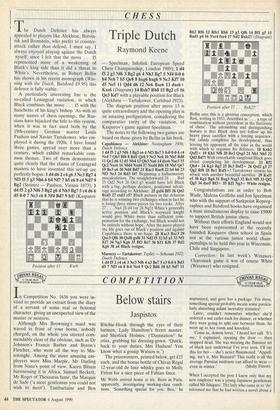CHESS
Triple Dutch
Raymond Keene
The Dutch Defence has always appealed to players like Alekhine, Botvin- nik and Bronstein, who prefer to counter- attack rather than defend, I must say, I always enjoyed playing against the Dutch nyself, since I felt that the move . . . f5 represented more of a weakening of Black's king side than it did a threat to White's. Nevertheless, as Robert Bellin has shown in his recent monograph (Win- ning with the Dutch, Batsford £9.95) this defence is fully viable.
A particularly interesting line is the so-called Leningrad variation, in which Black combines the move . . f5 with the tianchetto of his king's bishop. As with so many names of chess openings, the Rus- sians have hijacked the title to this system, when it was in fact used both by the 19th-century German master Louis Paulsen and Xavier Tartakower, who em- ployed it during the 1920s. I have found three games, spread over more than a century, which exhibit remarkable com- mon themes. Two of them demonstrate quite clearly that the claims of Leningrad masters to have invented this set-up are perfectly bogus: 1 d4 d6 2 c4 g6 3 Nc3 Bg7 4 Nf3 15 5 g3 Nh6 6 h4 Nf7 7 h5 e6 8 e4 Nd7 9 (Steinitz — Paulsen, Vienna 1873); 1 d4 f5 2 g3 Nf6 3 Bg2 g6 4 Nh3 Bg7 5 c4 d6 6 (15 0-0 7 Nc3 c6 8 Nf4 Bd7 9 h4! (Kasparov
Position after 13 . . . Kxe6
— Speelman, Infolink European Speed Chess Championship, London 1989); 1 d4 f5 2 g3 Nf6 3 Bg2 g6 4 Nh3 Bg7 5 Nf4 0-0 6 h4 Nc6 7 h5 Qe8 8 hxg6 hxg6 9 Nc3 Kf7 10 d5 Ne5 11 Qd4 d6 12 Ne6 Bxe6 13 dxe6+ Kxe6 (Diagram) 14 Bxb7 Rb8 15 Bg2 c5 16 Qe3 Kd7 with a playable position for Black (Alekhine — Tartakower, Carlsbad 1923).
The diagram position after move 13 is quite extraordinary and the opening play is an amazing prefiguration, considering the comparative rarity of the variation, of Kasparov's game against Speelman.
The notes to the following two games are based on those given by Bellin in his book.
Capablanca — Alekhine: Nottingham 1936; Dutch Defence.
1 d4 f5 2 g3 Nf6 3 Bg2 e6 4 Nf3 Be7 5 0-0 0-0 6 c4 Ne4 7 Qb3 Bf6 8 Rdl Qe8 9 Nc3 Nc6 10 Nb5 Bd8 11 Qc2 d6 12 d5 Nb4 13 Qb3 Na6 14 dxe6 Nac5 15 Qc2 Nxe6 16 Nfd4 Nxd4 17 Nxd4 Bf6 18 Nb5 Qe7 19 Be3 a6 20 Nd4 Bd7 21 Racl Rae8 22 b4 b6 23 N13 Nc3 24 Rd3 14? Beginning a hallucinatory nthcalculation. The straightforward 24 . . . Ba4 25 0d2 Ne4 26 Qe 1 g5 would have left Black with a big, perhaps decisive, positional advan- tage according to Alekhine. 25 gxf4 13f5 26 Qd2 Bxd3 27 exd3 c5? Black persists in the delusion that he is winning two exchanges when in fact he is losing three minor pieces for two rooks. After 27 . . . Na4 28 d4 (or 28 Ng5) White's generally active position and Black's wayward knight would give White more than sufficient com- pensation for the exchange, but Black would not be entirely without hope. After the move played the life goes out of Black's position and against Capablanca there is no hope. 28 Rxc3 Bxc3 29 Qxc3 Qf6 30 Qx16 gxf6 31 Nd2 15 32 b5 a5 33 Nn Kf7 34 Ng3 Kg6 35 BO Re7 36 Kn Kf6 37 Bd2 Kg6 38 a4 Black resigns.
Maroczy — Tartakower: Teplitz—Schonau 1922; Dutch Defence.
1 d4 f5 2 c4 e6 3 Nc3 Nf6 4 a3 11e7 5 e3 0-0 6 8c13 d5 7 Nf3 c6 8 0-0 Ne4 9 Qc2 Bd6 10 b3 Nd7 11
Bb2 Rf6 12 Rfel Rh6 13 g3 Qf6 14 Bfl g5 15 Radl g4 16 Nxe4 fxe4 17 Nd2 Rxh2!! (Diagram)
Position after 17 . . . Rxh2!!
Bellin says this is a glorious conception, which Reti, writing in 1933, described as '. . . a type of combination without precedent in the literature of chess'. The astonishing and distinguishing feature is that Black does not follow up his heavy piece sacrifice with a forcing sequence, but calmly completes his development, thus leaving his opponent all the nine in the world with which to organise his defences. 18 Kxh2 Qxf2+ 19 Khl N16 20 Re2 Qxg3 21 Nbl Nh5 22 Qd2 Bd7! With remarkable sangfroid Black goes about completing his development. 23 Rf2 Qh4+ 24 Kg! Bg3 25 Bc3 Bel+ 26 Qxf2 g3 27 Qg2 R18 28 Be! Rxf1+! Tartakower crowns his attack with another beautiful sacrifice. 29 KxO e5 30 Kgl Bg4 31 Bxg3 Nxg3 32 Rel Nf5 33 Q12 Qg5 34 dxe5 1113+ 35 Kfl Ng3+ White resigns.
Congratulations are in order to Bob Wade, Malena Griffiths and Jon Speelman who with the support of Sarkpoint Reprog- raphics and Batsford books have organised a mass simultaneous display to raise £5000 to support British junior chess.
Without their efforts England would not have been represented at the recently founded Kasparov chess school in Spain nor at the various junior world cham- pionships to be held this year in Wisconsin. Chile and Singapore..
Correction.. In last week's Winawer- Charousek gathe it was of course White (Winawer) who resigned.
















































 Previous page
Previous page